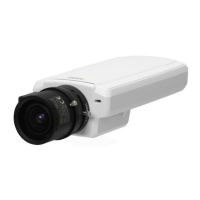
Do you have a question about the Axis P1344 and is the answer not in the manual?
| Video Compression | H.264, Motion JPEG |
|---|---|
| Optical Zoom | No |
| Digital Zoom | Yes |
| Video Compression Formats | H.264, Motion JPEG |
| Frame Rate | 30 fps |
| Image Formats Supported | JPEG |
| Ethernet LAN | Yes |
| Memory Card Slot(s) | No |
| Sensor Type | CMOS |
| Day/Night | Yes |
| Power Over Ethernet | Yes |
| Ingress Protection | IP66 |
| Field of View | 80° |
| Power | PoE |
| Network Interface | Ethernet |
| Camera Type | Fixed |
| Sensor Size | 1/4" |
| Minimum Illumination | 0.5 lux |
| White Balance | Auto, Manual |
| Signal-to-Noise Ratio (SNR) | 50 dB |
| Supported Resolutions | 640x480, 320x240 |
| Streaming Capability | Multiple, individually configurable streams |
| Network Protocols Supported | IPv4/v6, HTTP, HTTPS, FTP, SMTP, Bonjour, UPnP, SNMP, DNS, DynDNS, NTP, RTSP, RTP, TCP, UDP, IGMP, RTCP, ICMP, DHCP, ARP, SOCKS |
| Security Algorithms | HTTPS |
| Operating Temperature (T-T) | -10 °C to 50 °C |
| Aperture | F2.0 |
| Operating Conditions | -10 °C to 50 °C |
| Storage Temperature | -20 °C to 60 °C |
Legal notice concerning inaccuracies, omissions, and company liability for product use.
Information on patents, third-party software, and licensing details.
Guidelines on unauthorized equipment changes and their effect on certifications.
Listing of registered trademarks associated with the product.
Details on how to access support resources and contact assistance.
Description of all physical connectors for network, audio, power, and I/O.
Explanation of the status and network LEDs and their operational meanings.
Meaning of the status LED during Focus Assistant operation.
Step-by-step guide for safely replacing the camera lens.
Instructions for accessing the product's interface via a web browser.
Steps to enable external access to the product from the internet.
Guide to setting the primary administrator password for secure login.
Introduction to the main interface for live video and camera control.
Details on interactive buttons and controls on the Live View page.
How to operate Pan, Tilt, and Zoom features through the interface.
Utilizing the comprehensive PTZ control panel for precise movements.
Protocols and techniques for streaming video using H.264 compression.
Information on configuring and using Motion JPEG for video feeds.
Guidance on utilizing the AMC software for media stream access.
Various methods and players for accessing video streams.
Procedures for capturing and listening to audio from the product.
Essential first steps for configuring the camera after installation.
Defining video stream parameters such as resolution, frame rate, and codec.
Creating, modifying, and selecting predefined or custom stream profiles.
Adjusting image appearance including color, brightness, and sharpness.
Optimizing exposure for varying light conditions and motion clarity.
Specifying and configuring particular zones within the video feed.
Superimposing text, date, time, or custom images onto the video.
Setting up specific areas to be masked or hidden in the video stream.
Detailed steps for achieving optimal focus using manual and automatic methods.
Configuring microphone input, speaker output, and audio transmission modes.
Uploading and playing sound files for event notifications or alerts.
Choosing or creating stream profiles for the Live View display.
Adjusting viewer toolbar, decoder installation, and PTZ mode defaults.
Adding custom web or CGI links to the Live View page.
Enabling control of external devices (outputs) from the Live View interface.
Creating, saving, and recalling specific camera views.
Configuring automated camera tours between preset positions.
Customizing panel shortcut buttons and disabling PTZ features.
Setting up alarms for unauthorized camera tampering or image obstruction.
Defining detection areas, sensitivity, and history for motion events.
Detailed explanation of object size, history, and sensitivity settings.
Configuring alarms based on audio input levels and threshold triggers.
Process for uploading, installing, licensing, and running third-party software.
Defining triggers, conditions, and actions for event-driven operations.
Setting up destinations for notifications and event data.
Creating and applying time-based schedules for action rules.
Defining the frequency or repetition of action rules.
Viewing, playing, and downloading video recordings from storage.
Enabling and configuring the product for constant video recording.
Managing user accounts, permissions, IP filtering, and encryption.
Configuring IP addressing, DNS, NTP, and network services.
Setting up SD cards and network storage for recording data.
Managing I/O ports for external device integration and status.
Performing restarts, resets, and other system upkeep tasks.
Accessing system information, logs, and contact details for support.
Utilizing scripting, file uploads, and plain configuration for advanced users.
Procedure to restore all product settings to their original factory state.
Checking firmware version and procedures for upgrading.
Steps to recover the product after a failed firmware update.
Solutions for common issues with IP configuration and browser login.
Troubleshooting problems related to H.264 video rendering and playback.
Resolving problems with missing images, slow updates, and poor performance.
Diagnosing and resolving issues with audio playback and storage.
Detailed technical data for the camera sensor, lens, and illumination.
Technical data for video compression, resolution, frame rate, and audio codecs.
Information on supported protocols, security features, and APIs.
Factors affecting product performance such as bandwidth, CPU load, and client capabilities.